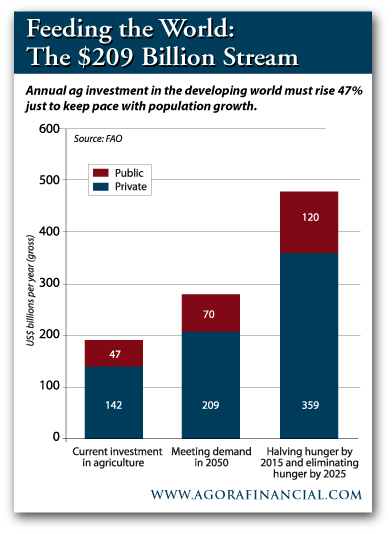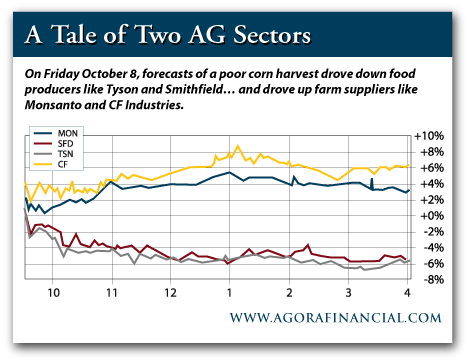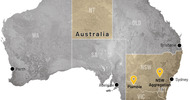The Daily Reckoning | 27 October 2010
By Addison Wiggin
Baltimore, Maryland – The short-term (1-3 year) outlook for agricultural commodities is bullish enough. When you start looking out decades, the picture becomes one of an epic bull market.
Feast on the following highlights from an August report by the United Nations Food and Agriculture Organization, working with the Organization for Economic Cooperation and Development…
* World population will grow 2.3 billion by 2050, to over 9 billion
* Nearly all this growth will come in developing countries* This population growth will require a 70% increase in global food production
* In developing countries, production will need to nearly double* Making this happen will require annual investment averaging $209 billion.
And if you break out the details, that $209 billion figure is just the private investment required if the percentage of the world that goes hungry stays static.

If hunger is to be eliminated in the next 15 years, that investment figure jumps to $359 billion.
Is it any wonder the FAO expects grain prices over the next 10 years to remain 15-40% above their levels of 1997-2006? Oh, and that’s before you adjust for inflation over the next ten years.
So who stands to profit from that annual investment of $209 billion to boost crop production? Hint: It won’t be food manufacturers. They’re going to be hit hard. Instead, you’ll want to be investing in the suppliers of fertilizer and/or farm equipment.
Every month, the Institute for Supply Management releases its Chicago-region Purchasing Managers Index – a gauge of manufacturing activity. The numbers are rarely as interesting as the comments from real businesspeople who respond to the survey.
In the survey released Sept. 30, one comment read: “Look for consumer food prices to rise soon. Food manufacturers simply cannot continue to absorb commodity increases.”
The market is just now waking up to this reality. On Oct. 8, when the Agriculture Department cut its forecast for the US corn crop, shares of Tyson, the chicken producer, dropped 6%. Smithfield, the pork giant, also took a hit. In contrast, seed giant Monsanto rose 3.5% and fertilizer maker CF Industries jumped 6%.
So again, who benefits from that $209 billion annual stream? Richard Feltes, an analyst at the RJ O’Brien brokerage in Chicago, perhaps puts it best: “Buy farm equipment stocks and sell food company stocks.”
There aren’t many ETFs that focus on the kind of stocks that went up on this chart. But the Market Vectors Agribusiness ETF (MOO) is one that does. MOO’s top 10 holdings make up nearly 60% of the entire fund. No. 1 on the list, making up 8.5% of the holdings, is Deere & Co. – the quintessential farm equipment stock. Nos. 2 and 3 are PotashCorp and Mosaic, the leading producers of fertilizer. Potash is the subject of a buyout battle right now, and its outcome is uncertain. Mosaic could well become a takeover target. So it’s a volatile, but also exciting, time for the sector.
MOO also gives you access to stocks you can’t buy on US exchanges, like Wilmar Intl., an Asian agribusiness giant. It’s the world’s largest producer of palm oil and the second-largest company ranked by market cap on the Singapore stock exchange. It’s a simple call. Buy MOO and hold it. We don’t know if you’ll be able to ride it all the way to when world population reaches 9 billion in 2050…but it’ll have staying power.
Farmland, itself, is another very compelling way to capitalize on the coming bull market in agricultural commodities. But buying farmland is, obviously, much more difficult than buying a share of stock.
“Productive agricultural land with water on-site will be very valuable in the future,” says Michael Burry, the hedge fund manager who bet against the housing bubble and the principal character in Michael Lewis’ best-selling book The Big Short. “I’ve put a good amount of money into that.”
Farmland has had a remarkably consistent return. A farmland index compiled by the National Council of Real Estate Investment Fiduciaries has risen an average 11.2% annually since 1992. There hasn’t been a single losing year. And only one losing quarter.
Within the United States, the average price of farm real estate has doubled over the last decade, to $2,140 an acre, according to the US Department of Agriculture.
Elsewhere in the world, the farmland rush is on. High-net-worth individuals like George Soros and Ted Turner are buying farmland in Argentina, for example. But the biggest buyers are the sovereign wealth funds of governments in countries where farmland is at a premium – think China, India and the sandy Middle Eastern countries.
They’re finding willing sellers in developing countries. Figures are hard to come by, but the World Bank estimates foreign investors of all stripes bought 111 million acres in the developing world in 2009 – a 10-fold increase in 10 years. Two-thirds of those deals have been struck in Africa.
The iconic example is a deal that fell through. In 2008, South Korea’s Daewoo Logistics signed a lease on farmland in Madagascar, the large island nation off Africa’s southeast coast. The company planned to plant corn on territory larger than the state of Connecticut.
Angry voters promptly ousted the government that leased the land. The new president revoked the lease, saying, “Madagascar’s land is neither for sale nor for rent.”
But Sudan’s is. Nearly 10 million acres of Sudanese farmland have been sold to foreign buyers between 2004-09. More than 6 million acres in Mozambique have also changed hands. Liberia, Ethiopia and Nigeria have likewise sold sizeable tracts.
For investors, it’s a high-risk proposition. Many of these governments are selling the land from underneath the peasants who tended it for generations and kicking them out. They’re not very happy about that. If they can’t get redress, they might well seek revenge. Even in countries where the rule of law and property rights has a stronger history, the rules can change in an instant. Brazil just passed a decree limiting acreage held by foreign-owned companies.
So the best opportunities for US investors may be close to home. But that presents a problem for just about anyone who doesn’t know the farming business: How do you capitalize if you want to buy farmland, but you don’t know a combine from a cultipacker?
That’s where a growing number of specialized funds are stepping in. Boston-based Hancock Agricultural Investment Group has 210,000 acres of holdings, almost all in the United States. Agcapita, a Calgary-based firm, has acquired more than 30,000 acres, mostly in Saskatchewan.
But beware…You can’t dabble in these funds the way you can a mutual fund or an ETF. The typical minimum investment is $25,000…and the typical minimum commitment is six years. Still, if you have the cash and the patience, farmland could provide the biggest payout of all as the agriculture sector booms over the next decade.
We’re talking about long-term trends here. Growing populations. More affluent populations seeking a better diet. A world farm system stretched to the max. But make no mistake – agriculture is volatile, and there will be shakeout periods.
How patient are you? When the grains and the ag stocks pull back, will you still believe in the long-term story strongly enough to hold on? I hope so, because the opportunity is enormous.
Regards,
Addison Wiggin
for The Daily Reckoning
















